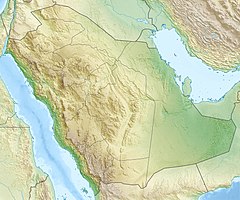
Back Ka'bah ACE Kaäba Afrikaans ከአባ Amharic الكعبة Arabic الكعبه ARZ কাবা Assamese Kaaba AST КагӀба AV Kəbə Azerbaijani کعبه AZB
| The Kaaba | |
|---|---|
ٱلْكَعْبَة (al-Kaʿba) | |
 The Kaaba in December 2020 | |
| Religion | |
| Affiliation | Islam |
| Region | Mecca Province |
| Rite | Tawaf |
| Leadership | President of the Affairs of the Two Holy Mosques: Abdul Rahman Al-Sudais |
| Location | |
| Location | Great Mosque of Mecca, Mecca, Hejaz, Saudi Arabia |
| Administration | The Agency of the General Presidency for the Affairs of the Two Holy Mosques |
| Geographic coordinates | 21°25′21.0″N 39°49′34.2″E / 21.422500°N 39.826167°E |
| Architecture | |
| Type | Temple[1] |
| Date established | Pre-Islamic era |
| Specifications | |
| Length | 12.86 m (42 ft 2 in) |
| Width | 11.03 m (36 ft 2 in) |
| Height (max) | 13.1 m (43 ft 0 in) |
| Materials | Stone, Marble, Limestone |
The Kaaba,[b] sometimes referred to as al-Ka'ba al-Musharrafa,[d] is a stone building at the center of Islam's most important mosque and holiest site, the Masjid al-Haram in Mecca, Saudi Arabia.[2][3][4] It is considered by Muslims to be the Bayt Allah (Arabic: بَيْت ٱللَّٰه, lit. 'House of God') and is the qibla (Arabic: قِبْلَة, direction of prayer) for Muslims around the world. The current structure was built after the original building was damaged by fire during the siege of Mecca by Umayyads in 683 AD.[1]
In early Islam, Muslims faced in the general direction of Jerusalem as the qibla in their prayers before changing the direction to face the Kaaba, believed by Muslims to be a result of a Quranic verse revelation to Muhammad.[5]
According to Islam, the Kaaba was rebuilt several times throughout history, most famously by Ibrahim (Abraham) and his son Ismail (Ishmael), when he returned to the valley of Mecca several years after leaving his wife Hajar (Hagar) and Ismail there upon Allah's command. Circling the Kaaba seven times counterclockwise, known as Tawaf (Arabic: طواف, romanized: tawaaf), is a Fard (obligatory) rite for the completion of the Hajj and Umrah pilgrimages.[4] The area around the Kaaba where pilgrims walk is called the Mataaf.
The Kaaba and the Mataaf are surrounded by pilgrims every day of the Islamic year, except the 9th of Dhu al-Hijjah, known as the Day of Arafah, on which the cloth covering the structure, known as the Kiswah, (Arabic: كسوة, romanized: Kiswah, lit. 'Cloth') is changed. However, the most significant increase in their numbers is during Ramadan and the Hajj, when millions of pilgrims gather for Tawaf.[6] According to the Saudi Ministry of Hajj and Umrah, 6,791,100 external pilgrims arrived for the Umrah pilgrimage in the Islamic year AH 1439 (2017/2018 CE).[7]
- ^ a b Wensinck & Jomier 1978, p. 319.
- ^ Butt, Riazat (15 August 2011). "Explosives detectors to be installed at gates of Mecca's Holy Mosque". The Guardian. Retrieved 23 May 2021.
- ^ Al-Azraqi (2003). Akhbar Mecca: History of Mecca. p. 262. ISBN 9773411273.
- ^ a b Wensinck, A. J; Kaʿba. Encyclopaedia of Islam IV p. 317
- ^ Mubārakfūrī, Ṣafī al-Raḥmān (2002). The Sealed Nectar: Biography of the Noble Prophet. Darussalam. ISBN 978-9960-899-55-8. OCLC 983834349.
- ^ "In pictures: Hajj pilgrimage". BBC News. 7 December 2008. Retrieved 8 December 2008.
- ^ "Umrah Statistics Bulletin 2018" (PDF). General Authority for Statistics. Kingdom of Saudi Arabia. Retrieved 28 May 2022.
Cite error: There are <ref group=lower-alpha> tags or {{efn}} templates on this page, but the references will not show without a {{reflist|group=lower-alpha}} template or {{notelist}} template (see the help page).
© MMXXIII Rich X Search. We shall prevail. All rights reserved. Rich X Search

